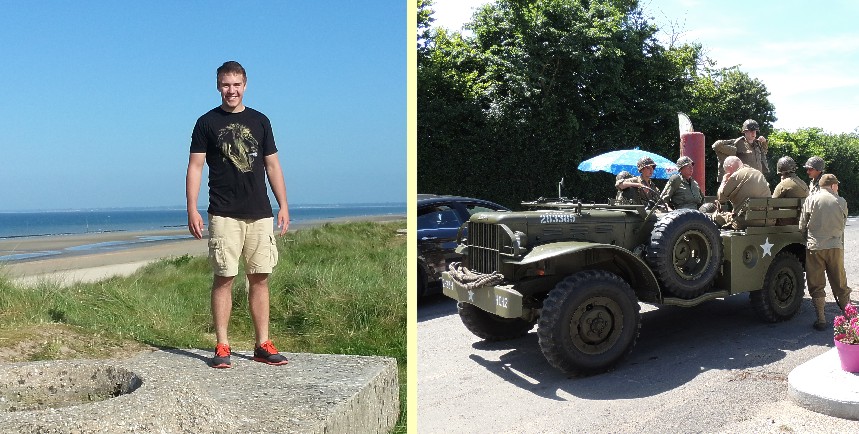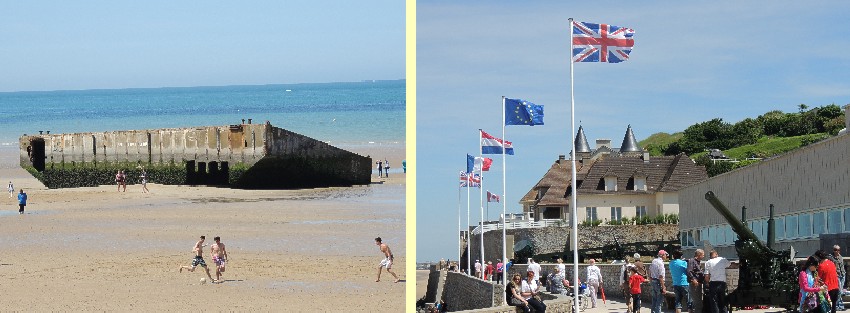Kansas Snapshots by Gloria Freeland - June 20, 2014
A quiet beach
I’ve always loved beaches. That feeling rose up in me recently as I walked in the sand during the late afternoon. My fascination with shells
led me to pick up several, comparing first one and then another with the ones younger daughter Katie had collected.
Nearby, older daughter Mariya and husband Art’s cousin’s children, Hannah and Ryan, seemed to enjoy the aimless wandering that a remote
beach can inspire. In the distance, the form of a few others could be seen, also enjoying the late afternoon sun on a day when the sky was a
cloudless blue and the gentle waves broke into small whitecaps here and there.
Yet looking out over the water in this peaceful setting, it was almost possible to mentally overlay a scene that took place here 70 years
ago. Art had climbed atop the bluffs behind the beach and had located the tops of several concrete fortifications. For the men who came
ashore on that June day, this was no peaceful place. For many of them, youngsters from all across America and thousands of miles from home,
this would be as close to Hell as it gets. This would be where many would take their last breath.
Earlier in the day, we had stopped in the small village of Vierville-sur-Mer to have a bite to eat at a sort of roadside diner erected
next to a small filling station. Red, white and blue flags - some U.S., some British, some Canadian and some French - were everywhere.
A blending of cultures could be found in Art’s hamburger. It was served in a baguette topped with fries. My foot-long hot dog was similarly
decorated and garnished with a generous helping of horseradish-laden French mustard.
Just as we were about to leave, a World War II-era Dodge truck appeared, turned around and stopped in front of the pump. The young men were
all dressed in olive-drab uniforms. For a moment, their joking made it seem as if we were somehow watching something that had happened seven
decades ago.
Then we had moved on to Ste. Mere Eglise and finally to this quiet section of Utah Beach. We also stopped at the Normandy American Cemetery
above Omaha Beach and visited Arromanches, where parts of the breakwater created by scuttled ships to form an artificial harbor could still be
seen.
In many ways, things have changed since our visit in 1995. This time, the beach towns seemed more “geared up” for tourists. In Arromanche,
boys played soccer near one of the World War II floats and hang gliders gently drifted from one of the bluffs to the beach below. People browsed
in military memorabilia shops and ate ice cream cones as they strolled along the sidewalks. 1940s-era music played over loudspeakers at
the tourist information office.
Hearing “The Last Time I Saw Paris“ and other songs from that time brought on a melancholy and disquiet I couldn’t quite explain. Many of
the generation who were adults or young children when those men stormed ashore were still around when we visited in 1995. Some were still
running the businesses and farming the fields that had been so bitterly fought over. For them, it was just part of their lives. They were
genuinely grateful, but just as the younger generation is now, were occupied by the demands of daily life.
But now, the older of those two generations is largely gone and the younger has turned over the running of day-to-day affairs to those
who have only heard and read accounts of what happened. The youngsters we saw in the truck bear a strong resemblance to those who came here
to liberate this beautiful land, but they cannot begin to appreciate the feelings of those who were here in earnest all those many years ago.
Ryan is very interested in what happened here, and Art has spent much time discussing with him the events that happened. A certain realization
seemed to strike Ryan one evening when he asked about his grandfather, who had been a B-29 pilot in the Pacific Theater. Ryan asked Art how old
his grandfather was when he entered the service. When Art answered 19, Ryan immediately responded, “The same age I am now.”
Most of that older generation, whether they were in the service or had contributed on the home front, didn’t talk about it much as the years
passed. When asked, their answers displayed a sort of reticence mixed with a combination of shyness and embarrassment. It was, after all, the
generation where drawing attention to oneself was considered unseemly. But their emotions were also a product of feeling that they were just the
lucky ones and the heroes were their comrades who never made it back.
Today, the D-Day beaches are scattered with museums. A new one at the Normandy American Cemetery is particularly well done as it focuses on a
few personal stories of those who served and died in France. It also includes a detailed timeline recounting the hour-by-hour happenings of June
6 and beyond. Still, as I watched a tour guide explain some of the details to his audience, I could almost feel how this event was slipping into
the past, just as World War I and the Civil War have. There was a spark of immediacy when a former air crew member who was in the crowd was asked
to say a few words. But it was brief as he, too, showed that reticence to draw attention to himself. A few asked to have their pictures taken with
him and he somewhat sheepishly agreed.
And then he walked briskly away. His leaving transformed the thousands of headstones, perfectly manicured grass and Wall of the Missing from
something of the present to something of the past.
Future generations will hear about what happened and the sacrifices made. But somehow something is lost when those flesh and blood individuals
who experienced it are gone. And it is a loss that cannot be replaced by written accounts, photographs or movies.
It is a loss I felt deeply, even while collecting shells on a quiet beach on a warm sunlit afternoon.

